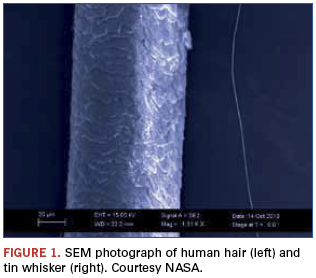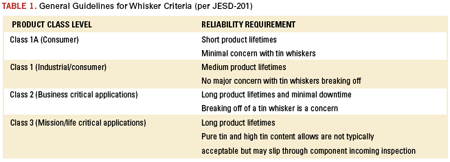No panacea exists, but certain coatings are getting closer.
What are the guidelines for tin whiskers in electronics assemblies, and how are they prevented? Part of the question can be answered by the Jedec and GEIA standards that delineate acceptance requirements for tin whiskers (Figure 1) in commercial and military hardware. But none of the methods outlined by the standards guarantees total mitigation of whisker growth.

No single accepted theory explains the tin whisker growth mechanism. The leading theories postulate the growth mechanism is powered by a release of internal stress in the tin finish or by re-crystallization and abnormal growth in the tin grain structure.1 Since the growth mechanism is not fully understood, the required environmental stress tests used for qualification, such as thermal cycling and thermal aging, do not necessarily simulate tin whisker growth in an assembly. A linear growth rate for tin whiskers has not been observed during long-term studies of whisker growth. There is a latency period after the coating is applied during which tin whiskers do not grow, which can range from a period of days to years. Once a whisker starts growing, it will most likely grow at a constant linear rate, but not all whiskers on a particular finish will grow at the same rate. This unpredictable whisker growth rate, which leads to inaccurate acceleration models, makes qualification testing of high-reliability electronics assemblies a challenge.
Qualification tests. For tin whisker acceptance testing, the commercial electronics industry has used Jedec standard JESD201, Environmental Acceptance Requirements for Tin Whisker Susceptibility of Tin and Tin Alloy Surface Finishes. Due to the long service life (>10 years) required for high-reliability electronics assemblies used in the aerospace and defense (A&D) industry (Table 1, Class 3), JESD201 requirements are not adequate. While valuable as a process evaluation tool for data comparison, the environmental test conditions do not correspond with actual A&D service environments. Tin whisker testing in JESD201 focuses on humidity, thermal cycling (1,500 cycles maximum), and calendar aging for a maximum of only 4,000 hr. (5.5 months). The A&D environment includes vibration, shock, corrosion, and even probe marks in the surface finish left behind during troubleshooting. These environmental conditions induce stress on the thin tin finish, which promotes the growth of tin whiskers.

GEIA-STD-0005-2, Mitigating the Effects of Tin Whiskers in Aerospace and High Performance Electronic Systems, is presently the adopted standard used to manage (but not eliminate) tin whisker risk. These mitigation methods include SnPb solder dipping of component leads, conductor spacing control, and conformal coating. Unfortunately, the current knowledge base does not include decades of experience to verify the success of these mitigation methods and their effect on system reliability.
Mitigation techniques. While pure tin and high tin content finishes are not recommended for Class 3 assemblies, the push to restrain A&D electronics costs has precipitated the use of COTS (commercial off-the-shelf) components whenever possible. Unfortunately, since pure tin finished devices are common and inexpensive, they have inadvertently made their way through A&D supply chains. Component manufacturers and distributors frequently use the lot number as the only discriminator to distinguish the Pb-free finish. Even reputable distributors have difficulty tracking lots of pure tin finished components versus the same component with an alternate finish.
As a first level of tin whisker mitigation, it is critical to screen for pure tin finished components at incoming receiving. Conformal coating, required for most military applications, is another whisker mitigation technique frequently used to help retard the effects of whisker growth. By isolating individual leads, the coating can prevent arcing due to whisker bridges. The more elastic coatings rely on elongation properties to prevent penetration. Other coatings rely on their hardness to restrain or redirect whiskers to grow back on themselves, preventing them from breaking through and potentially shorting. It must be reiterated that currently conformal coating is not a foolproof method to prevent whisker growth.
Various methods and materials are available for conformal coating. The following have been the most commonly used, with most having been qualified under IPC-CC-830. The coatings are listed in increasing order by their expected tin whisker mitigating value.
1. Acrylic: can be dipped or sprayed.
2. Silicone: can be dipped or sprayed.
3. Epoxy: can be dipped or sprayed.
4. Parylene: chemical vapor deposition.
5. Arathane 5750 (formerly Uralane 5750)2 Urethane: can be dipped or sprayed.
6. ALD-Cap3: high alumina ceramic applied using atomic layer deposition.
With research still pending, ALD-Cap high alumina conformal coating has shown encouraging signs as a reliable method for tin whisker mitigation.
References
1. Jay Brusse, Kim Jong, Michael Sampson and Henning Leidecker. “Basic Info on Tin Whiskers.” NASA Electronic Parts and Packaging (NEPP) Program, http://nepp.nasa.gov/whisker/background/index.htm.
2. Jay Brusse, Kim Jong, Michael Sampson and Henning Leidecker, “Characterize the Effectiveness of Arathane 5750 (formerly Known as Uralane 5750) Conformal Coat Material in Prohibiting Tin Whisker Formation and/or Tin Whisker Penetration.” NASA Electronic Parts and Packaging (NEPP) Program, http://nepp.nasa.gov/WHISKER/experiment/exp2/.
3. Ofer Sneh, “N04-058: ALD-Cap: Thin Film Encapsulating Coating for Hermetic Environmental Protection,” Navy SBIR Success Story, July 25, 2009. https://www.navysbirsearch.com/widgets/hyperlinking/successdetails.jsp?url=DocURL&id=90078.
4. The Lead-Free Electronics Manhattan Project – Phase I. Benchmarking and Best Practices, July 30, 2009. http://www.dodb2pcoe.org/LFEMP_book.pdf.
ACI Technologies Inc. (aciusa.org) is the National Center of Excellence in Electronics Manufacturing, specializing in manufacturing services, IPC standards and manufacturing training, failure analysis and other analytical services. This column appears monthly.















